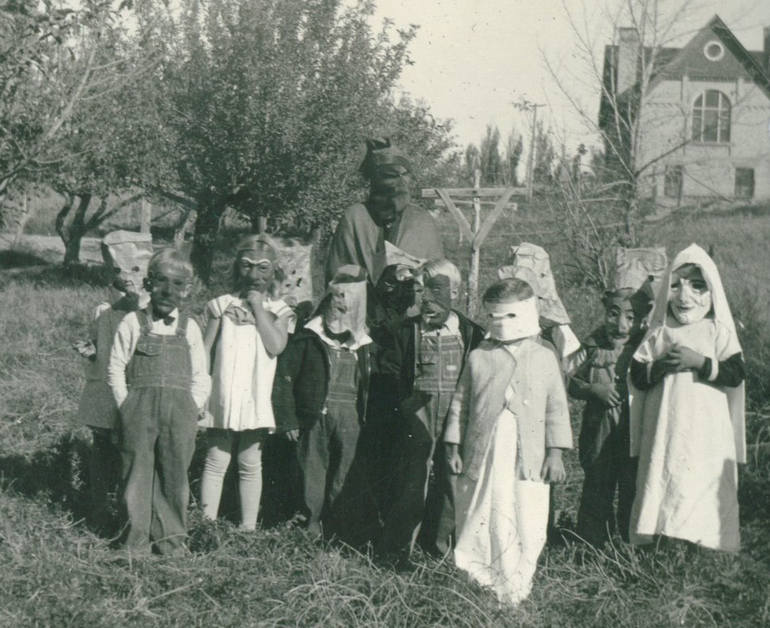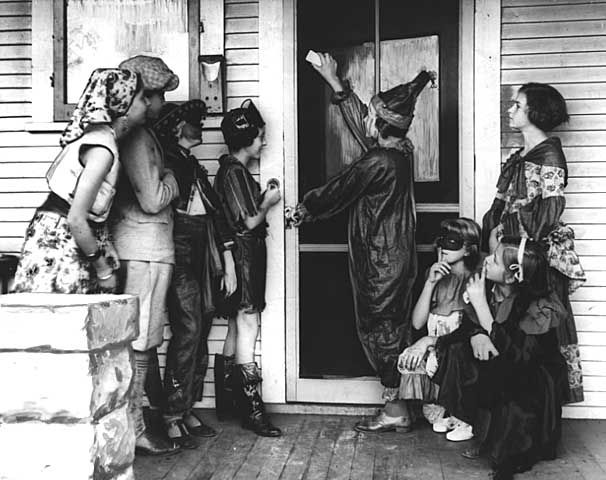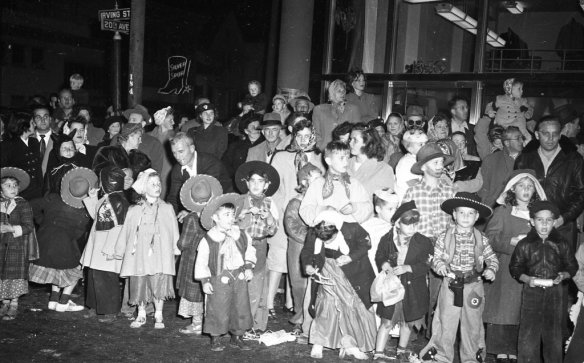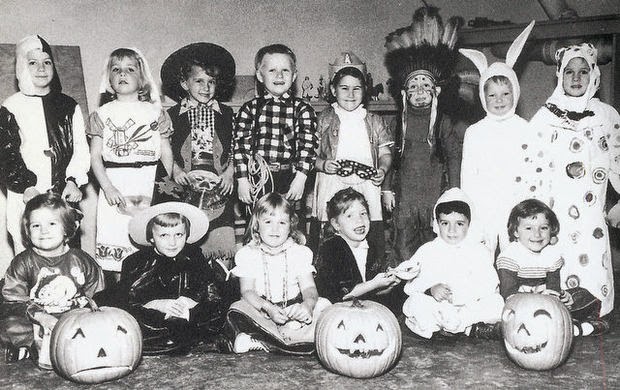From Scary Monsters to Superheroes: The Changing Face of Halloween
October 28, 2016 · CLASSMATES FUN
Image by Emery County Archives is licensed under CC BY 4.0
1920s
Back in the 1920s, Halloween in the United States was a holiday celebrated by both children and adults, usually in their homes (or in the homes of friends). The costumes were homemade, as were the refreshments. Masks were often made of papier mache (and could look incredibly creepy). Ghosts, witches, skeletons, and devils were common subjects, reflecting some of the holiday’s roots in the pagan ritual of warding off evil spirits. Fortune-telling was a popular party pastime. Halloween in the early 20th century was not just considered to be for families with young children, either. High school students and adults had their own parties, frequently with costume contests. The holiday had a dark side, too, in the form of pranks (a tradition that had already been going on in the U.S. for several decades). Some of these were more than just minor nuisances and could cause actual property damage.
Halloween tricks or treaters by Minnesota Historical Society is licensed under CC BY-SA 4.0
1930s
The previous decade had ended with the stock market crash of 1929, and the country was now suffering through the Great Depression. Money was tight, and the morale of the country was low. The Halloween pranks, which continued to get worse with each passing decade, were becoming a real problem. Add to that the fact that many people could no longer afford to hold extravagant parties, and it was clear that Halloween traditions needed a change. Community organizations started setting up activities to keep kids occupied. At the same time, licensed character costumes first appeared on the market. You could now dress as Mickey Mouse or Little Orphan Annie rather than be yet another ghost (although traditional costumes were still quite popular). And a new trend was getting started: Some kids (starting on the west coast) would knock on neighbors’ doors, offering to spare them from pranks if they were given a treat.
© Chronicle staff / The Chronicle
1940s
As the dominant event of this decade, World War II had a big effect on Halloween. Although the trend of trick-or-treating had now spread across the country (helped in part by U.S. media and merchandisers) sugar rations made sweet treats scarce. However, Halloween pranks were more discouraged than ever before and were even viewed as impairing the war effort (especially when property damage was involved). Communities did their best to keep kids entertained and out of trouble for the holiday. On the costume front, lots of kids were dressing up as superheroes and cowboys after the war ended as the country was swept up in a wave of patriotism. And the icon of the pinup girl (popular with soldiers away at war) led to a trend toward more revealing costumes for women.
© Red Bank Historic Preservation Commission
1950s
It was the era of post-war expansion as the baby boom began, and thousands of families moved to the suburbs. All those new subdivisions meant that trick-or-treaters could go farther in their quest for sweets. For the first time, kids were no longer only visiting neighbors they knew on Halloween. At the same time, candy companies started marketing their products specifically for this holiday. Homemade treats now had stiff competition. And plastic masks were now on the market, which made dressing up a lot easier. When all these factors were added together, you got a rapid increase in trick-or-treating across the country. On the costume front, the television set became a common fixture in more households, and new programming was continually being developed. Westerns were especially popular. This meant a new host of characters for costume subjects (and still a lot of cowboys and cowgirls). Meanwhile, in high schools, it was now common to hold a Halloween dance where a queen (and sometimes king) would be chosen. Quite a far cry from dressing up in scary costumes!
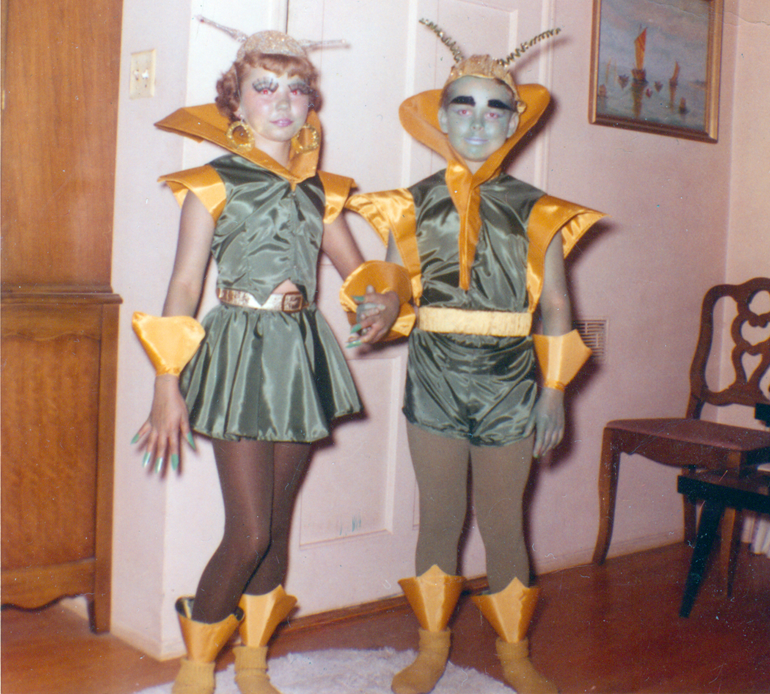
Martian Costumes Halloween 1960 by Fritz Liess is licensed under CC BY-NC-SA 4.0
1960s
The 1960s started off much like the 1950s, but things quickly grew tumultuous. The assassination of President Kennedy in 1963 arguably marked the end of innocence for the U.S., which saw protests, more assassinations, and involvement in a difficult and unpopular war before the decade was over. The country’s entertainment culture was going through changes as well. While 4 of the top 10 TV shows of 1960 were westerns, by 1965 the lineup was dominated by sit-coms and Batman (airing on two different nights!). Television was becoming an important part of American culture, which meant that more people than ever before were dressing up as popular characters for Halloween. Superhero and Planet of the Apes costumes became hits with the younger generation. And the catsuit became a thing when Catwoman made her appearance on Batman, furthering the emphasis on sexuality that was starting to be seen in women’s costumes. In the music scene, Beatlemania and a host of other acts were changing the face of pop music. Meanwhile, in 1966, It’s the Great Pumpkin, Charlie Brown debuted on television, cementing the popularity of trick-or-treating for millions.
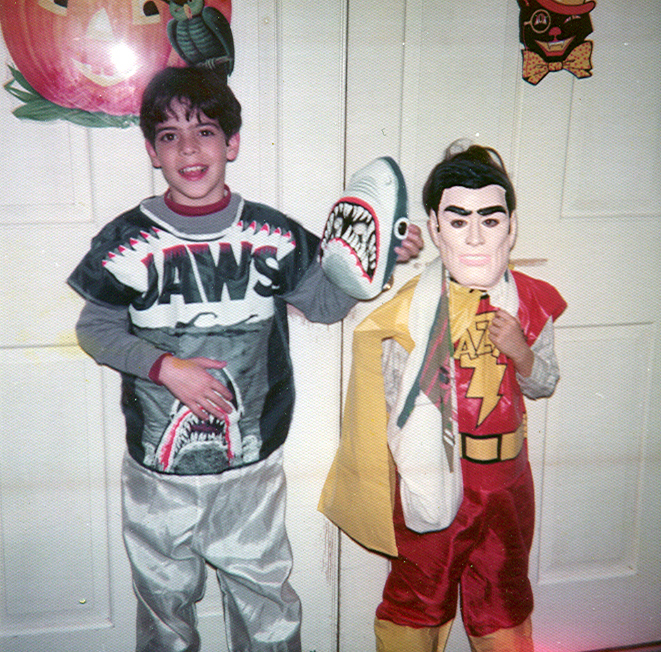
Mark and Ted on Halloween Night by Marco is licensed under CC BY 4.0
1970s
The 1970s may have been the golden age of trick-or-treating. While all was not easy in the U.S. (Vietnam, Watergate, and Three Mile Island were all in the news), kids were still free to roam around unattended. Candy options had grown (remember Pop Rocks, Wacky Packs, and Zotz?). And the entertainment industry was flourishing. Star Wars was the blockbuster hit of the decade (although Batman still ranked high). Saturday morning cartoons brought new characters (and accompanying advertising). The musical group KISS, with its perpetual stage makeup, seemed tailor-made for Halloween. This was also the decade in which scary movies really took things to the next level. The 1970s brought us The Exorcist, Jaws, The Omen, and Halloween (the first in a long line of slasher films), among many others. And an author named Stephen King showed up on the horizon. Costume manufacturers had tons of subjects to draw from, and the prepackaged plastic mask with accompanying costume was still the easiest way for kids to achieve the look they wanted. The one dark spot: According to this infographic, an urban legend about razor blades in apples had taken hold after the 1964 arrest of a New York woman, who had given ant traps and other undesirable “treats” to kids whom she thought were too old to be going door-to-door. Parents started inspecting their kids’ loot at the end of the night for suspicious food that needed to be thrown out. This spelled the end of the unpackaged treat.
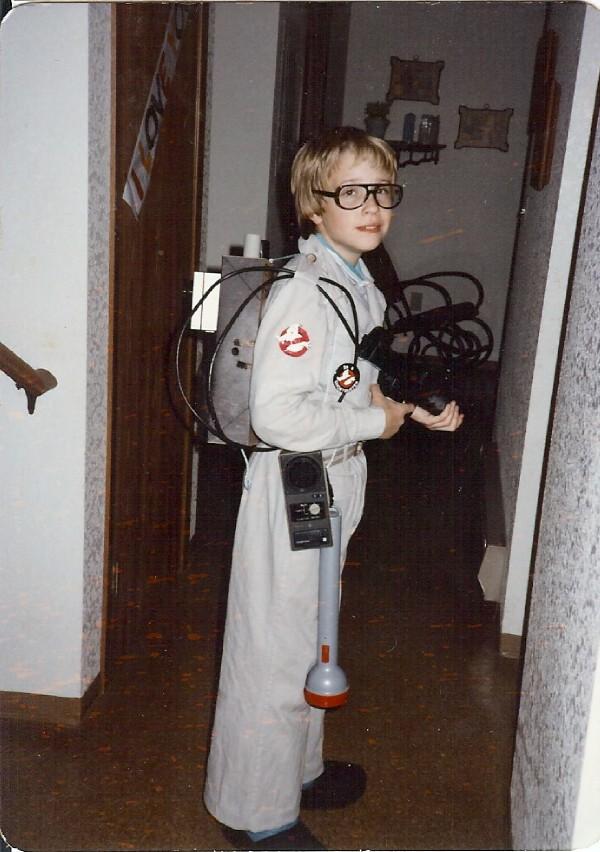
© Darth Sarcasm
1980s
Often referred to as a materialist decade, the 1980s brought lots of technological innovations: the first Macintosh, cell phones (the size of bricks but still portable!), Nintendo. It also brought the birth of MTV, which made pop stars much more visible than ever before and inspired many teens to emulate their looks. Elsewhere in entertainment, E.T., Back to the Future, Indiana Jones, and the Brat Pack were all introduced to the population (as well as two new Star Wars movies). Horror became even bigger as Stephen King continued to publish blockbuster novels, and new scary box office offerings were released. Along with Friday the 13th, A Nightmare on Elm Street, and Child’s Play came the concept of iconic movie killers as popular subjects for costumes. And the stereotype of the “yuppie” became a cultural phenomenon. New sources for Halloween costume inspiration were popping up left and right, and a lot of these weren’t available as a prepackaged disguise. People started getting creative. Trick-or-treating took a hit, though, after the Tylenol scare of 1982, in which seven people were killed by cyanide-laced tablets. New fears started to surface about that supposedly safe prepackaged candy, and people looked for ways to improve the safety of the Halloween experience. And concerns were raised about the vision-obscuring plastic masks that had been dominating the costume scene. Some people started holding parties instead of having their kids go trick-or-treating. And capitalizing on the rising trend of Halloween décor in the home, seasonal stores started to open around the country.
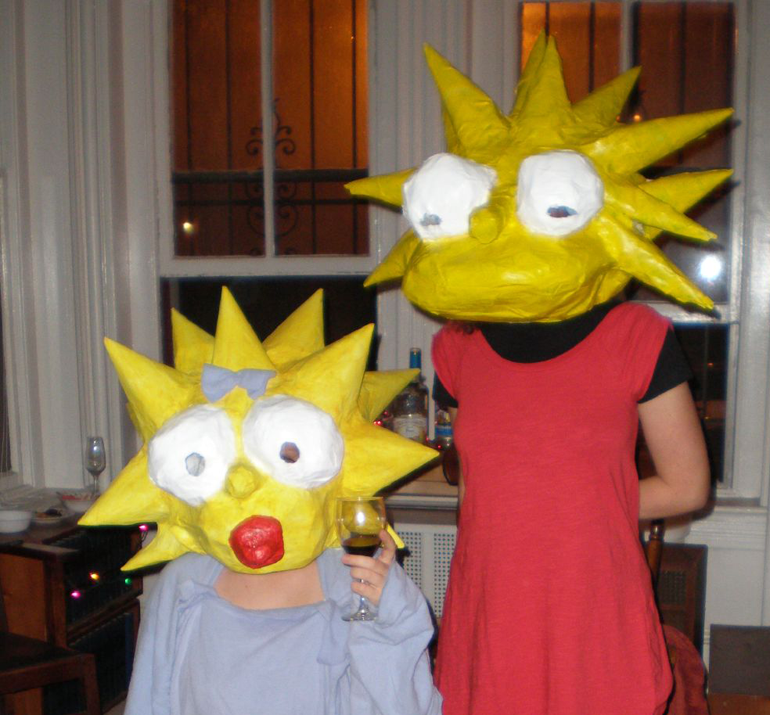
Lisa and Maggie Simpson by Libby is licensed under CC BY-NC-ND 4.0
1990s
Preceded by the fall of the Berlin Wall (1989), for the most part, the ‘90s was a pretty good time to be living in the U.S. The economy was thriving, and we continued to enjoy new technological advances, the most significant of which was the birth of the internet. Television program offerings were improving vastly (Seinfeld and The Sopranos premiered in this decade), and The Simpsons had become a huge hit. On the movie front, The Nightmare Before Christmas, Scream, The Matrix, and Pulp Fiction all debuted. And between the popularity of grunge music and hip hop, tattoos and other external expressions of individualism were becoming more visible. On top of all this, the rise of the 24-hour news cycle in television meant that we were constantly being bombarded with information. Cultural references were everywhere, and many of them made great fodder for Halloween costumes. And all those kids who had gone trick-or-treating in the 1970s were now young adults who were still celebrating. New licensed deluxe costumes started to push out the cheaper ones, and more people than ever turned to thrift stores and their own closets for inspiration. You could now expect to see anything from a witch to a Beanie Baby to a subtle sit-com reference at a Halloween party. And children in the ‘90s now had a new option that was just starting to be seen: Trunk-or-treating, viewed as a safer (although certainly less exciting) alternative to trick-or-treating, brought the concept of trick-or-treating to a parking lot of decorated cars.

Halloween Party at Government House by Maryland GovPics is licensed under CC BY 4.0
2000s to today
Between the internet, a constant stream of information, an amazing variety of entertainment options, and a trend toward more supervised parenting, Halloween has been changed significantly in the U.S. With the explosion of the internet and the introduction of the smartphone, people now have access to an incredible amount of information and entertainment. YouTube, social media, and reality television have led to more people sharing aspects of their lives with the public, for better or worse. And the 24-hour news cycle continues. Children are exposed to a lot of this and are growing up more quickly than ever before. On the entertainment side, we’ve seen Harry Potter, Twilight, a new generation of Star Wars movies, and The Hunger Games. The princess, once dominating the list of top children’s costumes, has been replaced by the superhero (now popular with girls as well as boys). And on the grown-up side, we’ve seen the peak and (thankfully) decline of “sexy” costumes (for everything from nurses to inanimate objects). There are now so many cultural references that you can come up with a costume for almost anything. And if you can’t buy it online, you can probably find out how to create what you want by browsing Pinterest (also an excellent source for décor and party treat ideas). So people have introduced more creativity to Halloween. Trick-or-treating, however, continues its decline. Play dates have replaced free-range play, and structured Halloween events have become the norm for many families. It’s the Great Pumpkin, Charlie Brown had its 50th anniversary airing this year, and it’s an increasingly nostalgic view of this country’s second-most popular holiday.
What were your favorite Halloween traditions when you were a kid? And how (if at all) do you celebrate today?
SHARE
